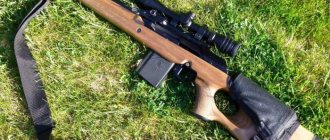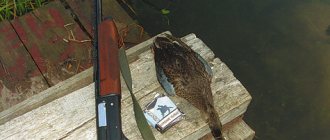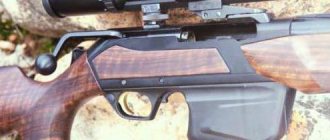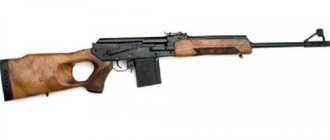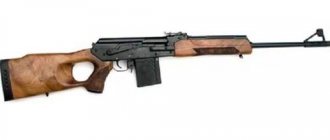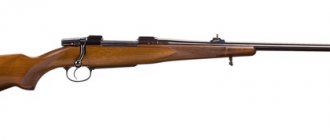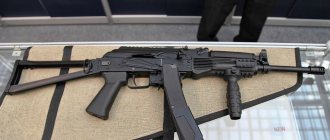Progress in the field of hunting weapons has allowed manufacturers to achieve not only improvements in quality and shooting characteristics, but also all the parameters that largely determine the level of demand for the models sold. Among the most popular rifles today, in particular, the MTs-558 rifle has established itself as an excellent choice not only for professional hunters, but also for beginners. The lightweight design, long receiver, modern, sophisticated design and balanced design of the entire rifle provide maximum comfort.
Among similar models offered on the market today, the MTs-558 also stands out for its excellent shooting characteristics. Range, determined by the initial flight speed, shooting accuracy and high lethality - all this is considered the main advantages of this model. Its ease of use and relatively small size make it suitable for teaching beginners. The ergonomic design makes it suitable for people with short stature and small hands.
Review of the MTs-558 carbine:
The MK-558 hunting carbine combines excellent shooting performance, stylish exterior design and high durability thanks to the use of high-quality modern polymer materials in all structural elements, which was well demonstrated during field tests. It is easy to use due to the absence of design complications and allows you to shoot at targets with a high degree of accuracy, since there are no unnecessary or intrusive elements when shooting.
Ergonomic external details and design make it easy to use. Simple and reliable, this model has excellent technical characteristics that allow advanced shooting from a carbine: a large number of positive reviews from both buyers and owners of the MTs-558 can also be considered an important indicator of quality.
Reviews of the MTs-558 model are available here.
Advantages and disadvantages
The most complete picture of the characteristics of a modern carbine can be obtained by analyzing its strengths and weaknesses, which reflect an objective view of the model. The MTs-558 carbine is one of the most frequently purchased models compared to other models and has several important advantages: it is convenient to carry , He
Sporting weapons by Viktor Denisov
Since the organization of TsKIB SOO, one of the main tasks has been the development and production of high-quality sporting weapons. After the Great Patriotic War, Soviet athletes, including shooters, began to actively participate in international competitions: Olympics, World and European Championships and Cups. It is known that shooting is a very difficult sport and in order to achieve high results, a country must have highly qualified shooting athletes and first-class weapons and ammunition. And it was out of the question that Soviet shooting athletes would shoot with foreign weapons and imported ammunition. And first-class weapons and ammunition can be created if there are qualified personnel who creatively solve the problems of designing sporting weapons.
One of these leading gunsmiths is Viktor Nikolaevich Denisov, a famous Tula gunsmith. Viktor Nikolaevich took his first steps in creating sports models at the initial stage of his creative path after being assigned to the TsKIB SOO at the end of the institute: he took an active part in the modernization of sports rifles MTs 12 and MTs 13. From these samples V. N. Denisov began the creation of sports rifles rifles. He developed the design and launched into production a series of rifles for sport shooting at a range of 50 m chambered for a 5.6 mm rimfire cartridge: MTs 112−02, MTs113−02 and MTs 114.
MC 112
MC 113
Rifle MTs-114
An important feature of the design of these rifles is the originality of the technical solutions incorporated and a high degree of unification of components and parts. The barrel is connected to the receiver via guide cylinders and threads. Locking is carried out by the bolt protrusions extending beyond the corresponding stops of the box. Cocking the trigger mechanism - when unlocking the barrel bore. The trigger mechanism is adjustable in terms of trigger force, stroke length and trigger position. The sight is diopter with automatic free movement compensation. Reloading weapons is manual.
When creating sporting rifles, both small-caliber and large-caliber, Viktor Nikolaevich developed a good creative relationship with Alexander Dmitrievich Sleptsov, the developer of large-caliber rifles. Together they attended shooting competitions with their samples. At first, the athletes treated the two specialists and their samples very coolly. Then the head coach of the Soviet Union national team, Viktor Nikolaevich Shamburkin, gained confidence in TsKIB SOO, its specialists and rifles. And athletes equipped with TsKIB SOO weapons began to win prizes.
And the position of TsKIB SOO in the shooting sport has become even stronger.
Viktor Nikolaevich worked a lot in the field of pneumatic weapons. As he says, he constantly had to compete with such foreign companies as Feinwerkbau, Anschutz, Walter and many others.
Such air rifles as MC 118, MC 119, MC 372 and MC 371 (gas-cylinder) were created. These samples were preceded by the MC 60−1 and MC 69−1 air rifles, and a lot of work was done to create MC commercial hunting rifles.
MC 118
Specifications
The main indicator of both the capabilities of a rifle and its shooting characteristics are its technical characteristics, which largely determine the quality of shooting, sights and firing range. Knowing the barrel type and weapon parameters will give you the most complete idea of its capabilities.
| Specifications | Carbine MK-558 |
| Country of Origin | Russia |
| Purpose | Hunting, sport shooting |
| Type | Large caliber calibrator with manual overload |
| Cartridge capacity | 5 rounds, original magazine can be replaced with a larger magazine |
| Overall barrel length | 1 120 mm |
| Types of cartridges used | 12.7 x 55 CTS-130, .300 lm, .338 lm |
| Trigger handle type | Trigger type |
| Barrel length | 625 mm |
| Model height | 202 mm |
| Weight | 4.89 kg |
| Width | 57 mm |
| Barrel type | Cold forging, oxide coating |
A cold forged barrel, high-quality scopes as standard, and valuable customer and owner reviews provide insight into the overall experience of this model.
Design
Thanks to its relatively simple design, you won't encounter any major problems when using this rifle, which is important for both beginners and advanced shooters. The main structural part of the rifle is the butt, as well as the receiver.
The receiver and stock are made of modern high-quality polymer materials, which allows the rifle to withstand temperature changes when used in the field and maintain an attractive appearance, since it is not subject to mechanical stress.
The beginning of the journey of a master gunsmith
The beginning of the creative path of gunsmith Viktor Nikolaevich was joining the Central Design Bureau of Sports and Hunting Weapons (TsKIB SOO) immediately after graduating from the Tula Polytechnic Institute. Viktor Nikolaevich remained faithful to his native enterprise during 55 years of work.
It is necessary to pay special attention to the fact that the direction of work activity chosen by Viktor Nikolaevich was determined in his early youth, by his origin and environment.
When Victor was born in 1935, his father Denisov Nikolai Kondratyevich and mother Denisova (Sidorova) Maria Dmitrievna, hereditary peasants, lived in Tula.
The Denisov and Sidorov family are peasants and hereditary gunsmiths, followers of Russian nuggets, peasant gunsmiths, who, by the decrees of the Rulers of Russia in the 16th - 17th centuries, were allowed to engage in the arms business.
His maternal grandfather, Sidorov Dmitry Vasilyevich, originally from peasants, in the 19th century with his relatives was involved in the weapons of the Tula Arms Factory - they assembled hunting weapons from factory parts.
D.V. Sidorov continued assembling weapons during the NEP. He took a direct part in the assembly of 12-gauge hunting shotguns, converted from Berdan rifles (model “K”), single-barreled Frolov rifles and samples of D. M. Kochetov (model “R”).
It is necessary to pay attention to the fact that TOZ in the 20s of the 20th century continued the tradition of the end of the 16th century - attracting peasants from the Tula region to carry out work on the manufacture of weapons from nearby villages. Entire villages were engaged in this trade and they had quite significant earnings. In particular, D.V. Sidorov lived in the village of Maryino near the village of Shatsk, Tula region. The family consisted of 6 people: himself, his wife, two sons and two daughters. They lived well: they had land, a house, a horse and a cow. The assembly of guns was carried out in a small workshop at the house. The family was a working family: they were engaged in agriculture in the summer, and assembling weapons mainly in the autumn-winter season and, as far as possible, during agricultural work.
Such work continued in Soviet times under the NEP until the state nationalized weapons production.
During the Great Patriotic War, men went to defend their Motherland: Dmitry Vasilyevich’s son, as well as Viktor Nikolaevich’s father, Nikolai Konstantinovich, laid down their heads on the battlefield, and Dmitry Vasilyevich replaced Victor’s father and he also passed on to the boy Vita a love of metal and weapons.
During the hard times of war, Victor’s further acquaintance with weapons continued. The family then lived on Galkin Street and the guys ran behind the railway track, where the captured weapons were stored. The security was terrible and the boys chose their weapons “to suit their taste”, then polished them until they shined, and then played war: “they beat the fascists!”
We came across weapons that were functional and even came with cartridges, and it’s good that these “combat campaigns” ended successfully.
The “raids” on the railway station later determined the future fate of Viktor Nikolaevich Denisov.
There was youth ahead. After finishing the seven-year school, he entered the technical school named after. S.I. Mosina. And then chance helped, he ended up in a group where he met good guys who were passionate about weapons technology, and he took his studies seriously.
Technical College named after S.I. Mosin in Tula.
A mathematics teacher and student group curator, Dmitry Pavlovich Budaev, had a great influence on Victor’s future fate at the technical school. Viktor Nikolaevich remembers D.P. Budaev with great gratitude: “It was he who put pressure on my pride and I came out into the public eye.”
After graduating from the technical school in 1954. S.I. Mosin with honors, Victor was sent from the technical school to study at the Tula Mechanical Institute (TMI) at the Faculty of Mechanical Engineering for the most prestigious specialty - the first and to this day does not regret it.
Victor studied with enthusiasm: he studied his favorite weapons, was the head of the group, and took an active part in public life.
Like other students, he took part in the raising of virgin soil in the Kazakh steppe: he participated in the harvest in the Pavlodar region. And his work in these construction teams was awarded the sign of the Komsomol Central Committee “For the development of virgin lands.”
My studies at the institute flew by quickly. At the end of his studies, Victor completed his diploma work under the guidance of the famous Tula gunsmith, outstanding designer of artillery cartridges and multiple launch rocket systems (MLRS) Alexander Nikitovich Ganichev. The topic of the work is the design of cartridges and modern aircraft guns. The work was successfully completed and protected perfectly.
Ganichev Alexander Nikitovich (1918−1983) was born in the village of Sudakovo, Leninsky district, Tula region. In 1938 he graduated from the Tula Industrial College, and in 1957 from the Tula Mechanical Institute. He began his career at the Tula Cartridge Plant. From 1945 until the end of his life, he worked at the newly organized Scientific Research Institute-147 (currently FSUE State Research and Production Enterprise Splav), rising from an engineer to deputy general director - chief designer. With his direct participation, the enterprise created 73 samples of artillery shells, developed and put into service more than 10 multiple launch rocket systems: “Grad”, “Uragan”, “Prima”, “Smerch”, etc., and rockets for them. A. N. Ganichev - Doctor of Technical Sciences, professor, author of 372 inventions, 45 scientific and technical articles, several monographs. The fruitful work of A. N. Ganichev in creating models of weapons and military equipment was recognized with high state awards. In 1971 he was awarded the title of Hero of Socialist Labor. A. N. Ganichev was awarded two Orders of Lenin, many medals, he is a laureate of the State Prize, the S. I. Mosin Prize.
Next was the distribution among enterprises of the Soviet Union.
The head of the then little-known enterprise - the Central Design Research Bureau of Sports and Hunting Weapons (TsKIB SOO) - Ivan Mikhailovich Mikhalev personally selected in 1958-1959. the best graduates of the institute on weapons topics, including Viktor Nikolaevich Denisov, whom he immediately began to load with real work, simultaneously teaching his methods of design and production support and solving engineering problems.
Ivan Mikhailovich Mikhalev (1909-1988) - Soviet gunsmith, designer, organizer of the creation and production of high-class sporting and hunting weapons. Born on August 28, 1909 in Tula. After graduating from a nine-year experimental demonstration school, he came to the Tula Arms Factory as a draftsman. In 1930-1934 he studied at the Tula Mechanical Institute. Returning to the plant, he worked as a fixture designer, senior designer, and head of the design group. In 1938-1939 he was sent to England and the USA to purchase equipment for the plant. During the Great Patriotic War, he worked at an evacuated plant in Mednogorsk - first as a production manager, and from February 1943 as a chief engineer-deputy director of the plant. In 1947, he was appointed head and chief designer of the Central Design Bureau of Sporting and Hunting Weapons (TsKIB SOO), which he headed until 1978. In 1978, I. M. Mikhalev was appointed as a released member of the scientific and technical council of the Ministry of Defense Industry, consultant to TsKIB SOO. He was repeatedly elected as a deputy of the Tula Regional Council of Workers' Deputies. I. M. Mikhalev died in Tula on May 21, 1988. Hero of Socialist Labor (1971). Awarded three Orders of Lenin (1962, 1969, 1971), Order of the Patriotic War, II degree (1945), two Orders of the Red Banner of Labor (1944, 1976), Red Star (1942), Badge of Honor (1966), five USSR medals and three gold medals VDNH. In 1963 the prize was awarded to them. S.I. Mosin. Honorary citizen of Tula.
By that time, the young engineer V.N. Denisov already had a certain engineering experience and, taking this into account, I.M. Mikhalev sent him to the disposal of such an experienced head of the design department and weapons designer as Vladimir Fedorovich Trukhachev, who had in his luggage the development of hunting weapons . In his department, V.F. Trukhachev created a business-like and friendly environment for his employees, so favorable for the improvement of young designers.
TsKIB SOO in our years.
In general, TsKIB SOO was a good school for a novice designer and a future outstanding specialist in rifled weapons. V.N. Denisov understood this perfectly, and his mentors V.F. Trukhachev and I.M. Mikhalev saw in this TMI graduate a representative of the future generation of TsKIB, their support and hope. And they were right.
The formation of Denisov V.N. began with the improvement of sporting rifles MTs 12 and MTs 13.
Rifle MTs 12.
Rifle M. Ts. 12 and Mts 13.
The young designer refined these models, which allowed them to remain in service with athletes to this day. The 7.62 mm MTs 13 rifle is even currently in service with sniper groups of special forces and security units of some republics of the former USSR. In the process of modernizing the MC 12 and MC 13, ergonomic indicators were improved (which is especially important for sports shooters), the trigger mechanism was improved, and the shape of the stock was changed. TsKIB SOO handed over modernized samples of MTs 12 and MTs 13−2 to members of the USSR national team. Based on the results of the shooting competitions, good reviews were received from the athletes.
In the early 60s, Viktor Nikolaevich tried his hand at a new area of hunting weapons - the development of self-loading carbines. He, together with Yu. P. Brovkin, creates a very successful design for the mass consumer - the MTs 26−09 hunting carbine. In terms of its technological characteristics, the MTs 26−09 carbine was superior to the then existing models: it had a welded receiver and a simple trigger mechanism. The carbine was tested in the Sea of Okhotsk under marine fishing conditions. Unfortunately, the carbine did not go into production.
V.N. Denisov, based on the S.I. Mosin carbine of the 1944 model, modified the KO-44−1 hunting carbine chambered for 7.62×54 R for large animals in commercial hunting conditions. Unlike the Mosin rifle, there is no bayonet, its fastening and a special mark is applied to the cartridge case and bullet during the shooting process. These marks allow you to identify the cartridge case and the bullet found after the shot.
KO-44−1.
Product prices
The cost indicator is the main factor determining the demand for the model. The large-caliber hunting carbine MTs-558, the price of which is 151,150-153,280 rubles, is popular even at a relatively high price, thanks to the attractive design of the model combined with its capabilities. For the same money you can buy, for example, Browning Maxus Sporting, Browning Bar .308 Boss, Remington 1100 COMPETITION, Fabarm XLR 5 or Remington VERSA MAX.
Cartridge for MC-558
